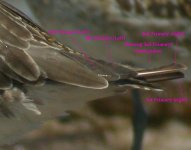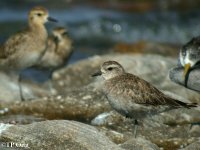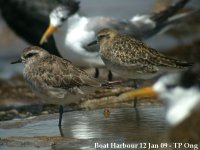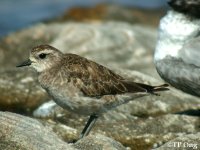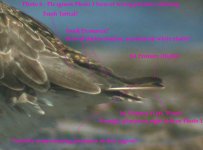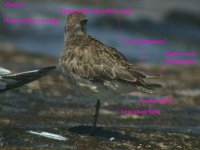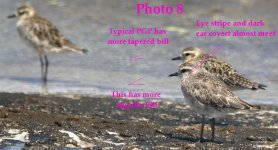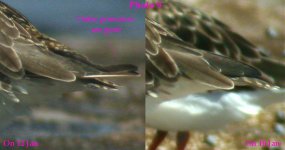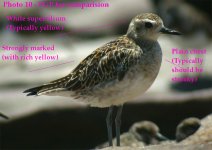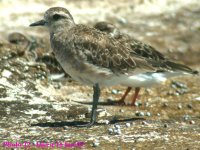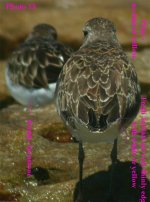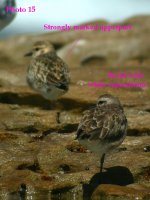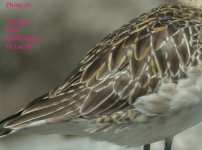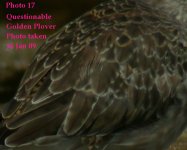tunpin.ong
Registered User
Dear fellow birders,
Today I visited a coastal rocky platform near Sydney Australia, which is popular for wader watching during high tide.
There were about 15 Pacific Golden Plovers roosting there and among them one individual was significantly drabber looking. I initially tried to avoid looking at it as it was the least attractive of all.
While I was photographing one of the Pacific Golden Plovers, this dull colour plover came into my view and my first impression was that this bird has shorter neck, shorter leg (tibia) and much plainer throat, chest and nape.
Unfortunately this is a heavily worn bird and supposedly a juvenile. Its left outermost primaries are even lost and invisible. See my attached close up photo and by extrapolating both its left and right primaries albeit some missing ones, I can argue that this bird should have at least 5 exposed primaries at each side.
Other points which I think that suggest American Golden Plover are:-
1) Although primaries are badly worn and even missing, there should be at least 5 exposed Primaries. (See my explaination in close up tail photo)
2) Shorter neck
3) Shorter upper leg (tibia) - consistant with all the PGPs beside
4) Overal very pale grey, yellow tint only on mantle and rump. White eyebrow.
5) Nape is very plain
6) Very plain throat and chest, hardly any streaks. Not even at sides of throat.
One juvenile American Golden Plover from Nova Scotia Canada posted on this forum looks very similar to the bird I say except the bird I saw is even worn (after long journey to Australia).
http://www.birdforum.net/gallery/showphoto.php?photo=35660
I also found some useful reference sites:
Consolidation of photos of AGP and PGP
http://www.birdinfo.com/A_Images_A/AmericanGolden-Plover_image.html
Field Identification of forms of Lesser Golden Plover by Dunn, Morlan and Wilds.
http://fog.ccsf.edu/~jmorlan/goldenplover2.pdf
I took many photos of this bird but seems to get its left side only. Also have typical Pacific Golden Plovers at its side for comparison.
Although I think most features suggest to American Golden Plover but there have been very very few official accepted record of American Golden Plover in Australia.
Thank you in advance on your suggestions, which supporting my claims or not.
Best regards,
Tun-Pin
Today I visited a coastal rocky platform near Sydney Australia, which is popular for wader watching during high tide.
There were about 15 Pacific Golden Plovers roosting there and among them one individual was significantly drabber looking. I initially tried to avoid looking at it as it was the least attractive of all.
While I was photographing one of the Pacific Golden Plovers, this dull colour plover came into my view and my first impression was that this bird has shorter neck, shorter leg (tibia) and much plainer throat, chest and nape.
Unfortunately this is a heavily worn bird and supposedly a juvenile. Its left outermost primaries are even lost and invisible. See my attached close up photo and by extrapolating both its left and right primaries albeit some missing ones, I can argue that this bird should have at least 5 exposed primaries at each side.
Other points which I think that suggest American Golden Plover are:-
1) Although primaries are badly worn and even missing, there should be at least 5 exposed Primaries. (See my explaination in close up tail photo)
2) Shorter neck
3) Shorter upper leg (tibia) - consistant with all the PGPs beside
4) Overal very pale grey, yellow tint only on mantle and rump. White eyebrow.
5) Nape is very plain
6) Very plain throat and chest, hardly any streaks. Not even at sides of throat.
One juvenile American Golden Plover from Nova Scotia Canada posted on this forum looks very similar to the bird I say except the bird I saw is even worn (after long journey to Australia).
http://www.birdforum.net/gallery/showphoto.php?photo=35660
I also found some useful reference sites:
Consolidation of photos of AGP and PGP
http://www.birdinfo.com/A_Images_A/AmericanGolden-Plover_image.html
Field Identification of forms of Lesser Golden Plover by Dunn, Morlan and Wilds.
http://fog.ccsf.edu/~jmorlan/goldenplover2.pdf
I took many photos of this bird but seems to get its left side only. Also have typical Pacific Golden Plovers at its side for comparison.
Although I think most features suggest to American Golden Plover but there have been very very few official accepted record of American Golden Plover in Australia.
Thank you in advance on your suggestions, which supporting my claims or not.
Best regards,
Tun-Pin




